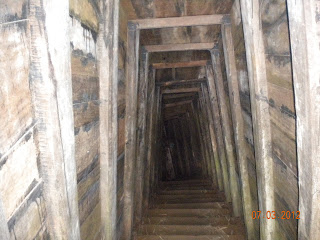We flew from Siem Reap directly to Ho Chi Minh City, then immediately to Da Nang. How familiar these names are, bringing back the war news from the '60s and early '70s, when Da Nang housed a huge US air base, and Ho Chi Minh was the leader of the forces fighting for an independent, unified Vietnam.
We have heard of many of these places, part of the war we all came of age opposing. In memory of those times, and in memory of those thousands who died fighting US domination, we toured some of the famous places of that era.
We started in Hue, an ancient city that became the old capital under the Nguyen dynasty, beginning in 1802. It continued as the capital of Vietnam until 1945, when the emperor abdicated and a new, communist regime was established in Ha Noi. The Citadel, an immense fortress, sits in decaying splendour on the north bank of the Perfume River, with moats on the other three sides. Some parts of it were severely damaged by American bombing, and the entire city was captured briefly during the Viet Cong Tet offensive. We spent an evening in a pleasant walk through the grounds, while Vietnamse boys played numerous games of soccer in the park. Within the Citadel
lies the Imperial Enclosure, where business of the state and Imperial functions were carried out, and within that the Forbidden Purple City which was reserved for the private life of the emperor. The only servants allowed inside the Forbidden Purple City were eunuchs, who posed no threat to the emperor's concubines. Now, all are welcome during visiting hours, including eunuchs, but the concubines are a distant memory.
Our second day here was devoted to a tour of the DMZ (The DeMilitarized Zone for you youngsters). This zone was on either side of the fictional border between northern and southern Vietnam. We saw a portion of the Ho Chi Minh Trail, the infiltration and supply route from the communist-held north. It looks very unimpressive now, but was the scene of a great deal of bombing and savage fighting as American troops attempted to interrupt or prevent the supplies and troops from making it further south. We also visited the site of the great seige at Khe Sanh, where American troops held out while suffering severe losses to keep a piece of real estate that had little military value, but was key to propaganda that illustrated American dominance. It's now mostly given over to the cultivation of rice, coffee and other crops, with a few bunkers and relics on display, including some captured American helicopters
and a transport plane. Locals sell momentos, like medals and dog tags, that have been dug out of the battlefield.
The DMZ is a complete misnomer, as it was one of the most heavily bombed areas of the war. A portion of it has been left as it was, with crters from bombs and shells overlapping on the scarred landscape. North of the DMZ is a vast tunnel network, parts of which have been maintained and are still accessible.
Local people used this network to shelter in during shelling and bombing, and it was part of the defensive works in the event that American troops should venture north. Some parts of this tunnel complex are over 23 meters deep. Over 200 people lived there full-time, and seven babies were born down in the tunnels.
The war that was fought against American dominance is now long past, and 37 years later this society looks like nothing that either side anticipated.
Sunday, March 18, 2012
Subscribe to:
Post Comments (Atom)



No comments:
Post a Comment